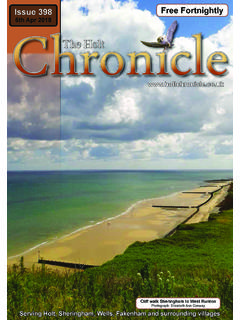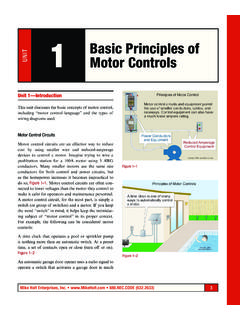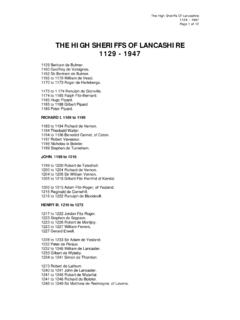Transcription of CHAPTER 8: COMMUNICATIONS SYSTEMS - Mike …
1 CHAPTER 8: COMMUNICATIONS SYSTEMS2005 CODE CHANGES116 Mike holt Enterprises, Inc. 8 of the National Electrical Code coversthe wiring requirements for COMMUNICATIONS systemssuch as telephones, radio and TV antennas, satellitedishes, closed-circuit television (CCTV), and cableTV (CATV) SYSTEMS , as well as network-poweredbroadband COMMUNICATIONS SYSTEMS , not under theexclusive control of the COMMUNICATIONS SYSTEMS aren t subject to thegeneral requirements contained in CHAPTER 1 throughChapter 4 or the special requirements of CHAPTER 5through CHAPTER 7, except where there s a specific ref-erence in CHAPTER 8 to a rule in one of those chapters[ ].Also, installations of COMMUNICATIONS equipmentunder the exclusive control of COMMUNICATIONS utilitieslocated outdoors, or in building spaces used exclusivelyfor such installations, are exempt from the NEC[ (B)(4)].ARTICLE 800 COMMUNICATIONS CIRCUITSThis article has its roots in telephone , it addresses telephone and relatedsystems that use twisted-pair wiring.
2 Here are afew key points that you need to remember from Ar-ticle 800: Don t attach incoming cables to the service entrancepower mast. It is critical to determine the point of entrance forthese circuits. You must ground the primary protector as close aspracticable to the point of entrance. Keep the grounding conductor for the primary pro-tector as straight and as short as possible. If you locate cables above a suspended ceiling,route and support them to allow access via panelremoval. Keep these cables separated from lightning-protec-tion circuits. If you install cables in a CHAPTER 3 raceway, youmust do so in conformance with the NEC requirementsfor the raceway system . Special labeling and marking provisions apply follow them 8: COMMUNICATIONS SYSTEMSPART I. Other Articles Text revised to specify that the accessible portion ofcommunications cables must be removed.(C) Spread of Fire or Products of limit the spread of fire or products of combustionwithin a building, the accessible portion of opticalfiber cable that isn t terminated at equipment and notidentified for future use with a tag must be removed.
3 (Figure 800-1)Author s Comment: This rule doesn t require theremoval of concealed cables that are abandoned Mechanical Execution of Work New FPN alerts the Code user to a comprehensivestandard that identifies what installed in a neat and work-manlike manner and cabling must be installed in a neat andworkmanlike : FPN: FPN: FPN: FPN: Information describing industry practices canbe found in ANSI/NECA/BICSI 568, Standard forInstalling Commercial Building 800-12005 CODE CHANGESCHAPTER 8: COMMUNICATIONS SYSTEMSMike holt Enterprises, Inc. IV. GROUNDING Cable and Primary ProtectorGrounding New FPN alerts the Code user that limiting thelength of the grounding conductor for the primary pro-tector should reduce voltages that may develop betweenthe building s power and COMMUNICATIONS SYSTEMS dur-ing a lightning event.(A) Grounding Conductor. The grounding conductor must be:(4) Length. The grounding conductor must be as short aspracticable.
4 In one- and two-family dwellings, the ground-ing conductor cannot exceed 20 ft. (Figure 800-2)FPN: FPN: FPN: FPN: FPN: Limiting the length of the grounding conductors re-duce differences in potential between the building s powerand COMMUNICATIONS SYSTEMS during lightning : Where it isn t practicable to limit the grounding con-ductor to 20 ft for one- and two-family dwellings, a sepa-rate ground rod not less than 5 ft long [ (B)(2)(2)]with fittings suitable for the application [ (C)]must be installed. The additional ground rod must bebonded to the power grounding electrode system with aminimum 6 AWG conductor [ (D)].ARTICLE 810 RADIO AND TELEVISION EQUIPMENTThis article has its roots in COMMUNICATIONS . Conse-quently, it addresses transmitter and receiver equipment and wiring and cabling associated with that are a few key points to remember from Article 810: Avoid contact with conductors of other SYSTEMS . Don t attach antennas or other equipment to the ser-vice entrance power mast.
5 If you do not ground the mast properly, voltage surgescaused by nearby lightning strikes could destroy it. Keep the grounding conductor straight, and protectit from physical damage. If you do not bond the mast properly, you risk flash-overs and possible electrocution. Keep in mind that the purpose of bonding is to preventa difference of potential between metallic objects and otherconductive items, such as swimming pools. Thus, Article810 provides several different bonding requirements. Clearances are critical. Article 810 provides extensiveclearance requirements. For example, it provides separateclearance requirements for indoor and outdoor II. RECEIVING EQUIPMENT - Grounding Conductors New subsection clarifies the type of grounding elec-trode termination fitting that is suitable for the discharge-unit grounding conductor.(K) Electrode Connection. Termination of the groundingconductor must be by exothermic welding, listed lug,listed pressure connector, or listed clamp.
6 Grounding fit-tings that are concrete-encased or buried in the earth toFigure 800-2 Figure 810-1








